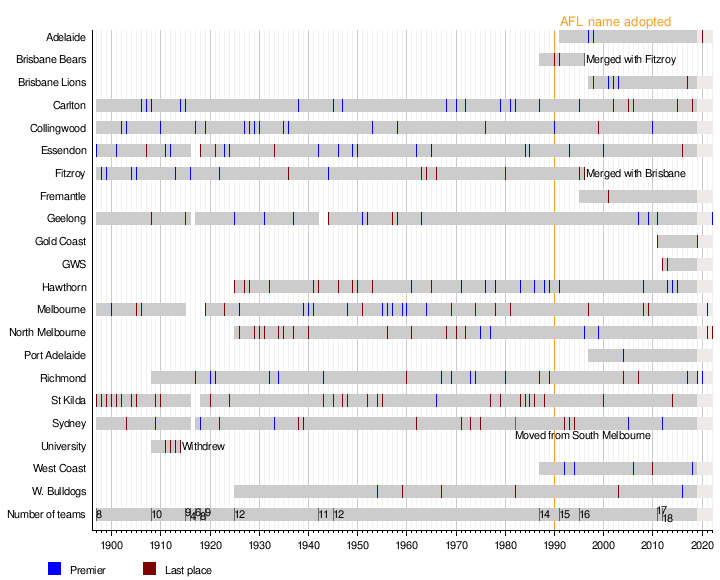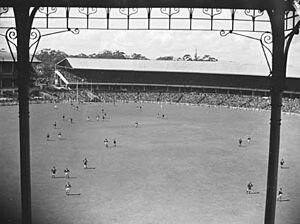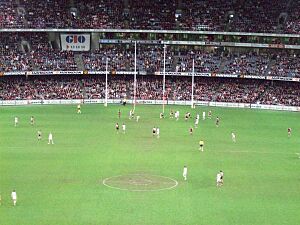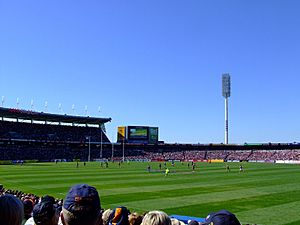History of the Australian Football League facts for kids
The AFL (Australian Football League) is the best professional Australian rules football league in the world. It has 18 teams. Nine teams are from Melbourne, one from country Victoria, and eight from other Australian states. The league started in Victoria in 1897. It was called the VFL (Victorian Football League) until the 1980s, when teams from other states joined.
Contents
How the VFL Began
The Victorian Football League started in 1896. Six strong clubs from Victoria left another league to form the VFL. These clubs were Collingwood, Essendon, Fitzroy, Geelong, Melbourne, and Sydney Swans. They invited two more clubs, Carlton and St Kilda, to join for the first season in 1897.
The new league brought in some cool ideas. They started an annual finals tournament instead of just giving the championship to the team with the best record. They also set up the modern scoring system: six points for a goal and one point for a behind.
The VFL quickly became the top football competition in Victoria. In the early years, Fitzroy and Collingwood were very strong. Then, Carlton became dominant from 1906 to 1908, winning three championships in a row. This was thanks to Jack Worrall, who is seen as the league's first official coach. Essendon also won championships in 1911 and 1912 with Worrall as coach.
In 1908, the league grew to ten teams. Richmond and University joined. University struggled a lot, losing 51 games in a row. Their players focused on studies, and the club was amateur when others paid players. University left the VFL in 1914.
Between the World Wars (1914–1945)
In 1919, the VFL added a seconds/reserves competition. In 1924, they started the Brownlow Medal. This award goes to the player voted the "fairest and best" by the umpires. Richmond won their first championships in 1920 and 1921. Essendon then became the top team from 1922 to 1926.
In 1925, the VFL expanded again, going from nine to twelve teams. Footscray, Hawthorn, and North Melbourne joined. North Melbourne and Hawthorn were very weak for a long time. Footscray, however, adjusted well to the VFL.
Between 1927 and 1930, Collingwood made history. They became the first and only team to win four championships in a row! In 1929, they didn't lose a single game during the regular season. This team was called "the Machine" because they played so well together. By 1936, Collingwood had won 11 championships, more than any other club.
In the 1930s, Richmond and South Melbourne were also top teams. Melbourne won three championships in a row from 1939 to 1941. Essendon also had a strong period, playing in nine grand finals between 1941 and 1951.
The 1950s: New Stadiums and TV
In 1946, the VFL started an Under-19s competition. In 1951, the McClelland Trophy was created for the best club across all three grades (seniors, reserves, and Under-19s). In 1952, the VFL held 'National Day', playing all six matches outside Melbourne in different states and country towns.
In 1959, the VFL planned to build its own huge stadium, VFL Park. This would give them independence from the Melbourne Cricket Ground. VFL Park was meant to hold 155,000 people, making it one of the world's largest stadiums. It was eventually built with a capacity of 78,000.
Geelong was the best team in the early 1950s, winning the 1951 championship. They then set a record of 23 wins in a row, including the 1952 championship. In 1954, Footscray won its first championship.
Melbourne became a powerhouse in the 1950s and early 1960s. Led by coach Norm Smith and star player Ron Barassi, they played in seven grand finals in a row from 1954 to 1960. They won five championships, including three in a row from 1955 to 1957.
Television coverage of games started in 1957. At first, the VFL worried that TV would reduce crowds. So, in 1960, they stopped all coverage. But in 1961, replays were allowed in Melbourne. Other states could watch live games every Saturday.
The VFL Premiership Trophy, which looks much like today's trophy, was first given out in 1959.
The 1960s: TV's Big Impact
Television had a huge impact on the VFL in the 1960s. Fans rushed home to watch replays. Many former players became commentators. There were also TV shows featuring VFL players, which helped them earn more money and showed off their popularity.
The VFL also started playing exhibition matches in 1962 to make the league more known around the world.
Hawthorn won its first championship in 1961. Melbourne continued its success, winning in 1964. But their winning streak ended when Ron Barassi moved to Carlton as a player-coach. Melbourne didn't reach the finals again for 25 years.
St Kilda, a club that had never won a championship in over 93 years, finally won its first and only one in 1966. It was a famous grand final victory against Collingwood, won by just one point!
The 1970s: New Rules and Big Games
In the 1970s, wealthy clubs gained an advantage by recruiting players from country areas. This created an imbalance between teams. From 1972 to 1987, only six of the twelve clubs played in grand finals.
The 1970 season saw the opening of VFL Park. The first game was played there on April 18, 1970. Even the Queen of Australia, Elizabeth II, attended and officially opened the stadium. The 1970 grand final between Carlton and Collingwood is one of the league's most famous games. Carlton came back from 44 points down at half-time to win by ten points! A record crowd of 121,696 watched this amazing game, which included a famous mark by Alex Jesaulenko.
Carlton and Richmond each won three championships between 1968 and 1974. North Melbourne, after struggling for years, finally won its first championship in 1975. They played in the grand final every year from 1974 to 1978, winning two. Carlton then won three championships in four years, from 1979 to 1982.
Some important rule changes in this decade included:
- The finals series expanded from four teams to five in 1972.
- The "centre diamond" (later a square) was introduced to limit players around the centre bounce.
- A second field umpire was added in 1976.
- Unlimited interchange (player rotations) was introduced in 1978.
The 1980s: Going National
The 1980s brought big changes to Australian football. The VFL was the most popular league, with the most fans and money. It started looking to expand into other states. VFL clubs could already afford to recruit top players from anywhere in Australia. This also meant some weaker Victorian clubs faced financial trouble.
In 1982, South Melbourne became the first VFL club to move interstate, becoming the Sydney Swans. In the mid-1980s, under wealthy owner Dr Geoffrey Edelsten, Sydney became a successful team. In 1987, the West Coast Eagles (from Western Australia) and the Brisbane Bears (from Queensland) joined the VFL. These new teams paid millions of dollars to join.
The 1980s also saw new regular timeslots for VFL matches. Games had always been on Saturday afternoons. But Sydney started playing on Sunday afternoons, and North Melbourne began playing on Friday nights. These are now common times for all teams.
Later in the 1980s, rules that limited where clubs could recruit players were removed. The first National Draft was introduced in 1986, and a salary cap (a limit on how much clubs could pay players) started in 1987. These changes helped make the clubs more equal.
In 1984, the International Rules series against Gaelic football players from Ireland was brought back. This led to Irish players like Sean Wight and Jim Stynes joining the VFL. Many Irish players have played professional AFL football since then.
On the field, Hawthorn, Essendon, and Carlton dominated the 1980s. Hawthorn played in seven grand finals in a row, winning four. Essendon and Hawthorn developed a fierce rivalry. The 1989 Grand Final between Hawthorn and Geelong is famous for being one of the toughest and most exciting games ever.
The AFL Era
The 1990s: A National League
In 1990, the league officially changed its name to the Australian Football League (AFL) to show it was now a national competition.
Collingwood won the 1990 AFL Grand Final, ending a 32-year championship drought. They had lost eight grand finals before this win, a period known as the "Colliwobbles."
In 1991, the Adelaide Crows joined the league as the fourth interstate club. The same year, the West Coast Eagles became the first interstate club to reach the grand final, though they lost. But the Eagles went on to win championships in 1992 and 1994. In 1995, the Fremantle Football Club from Western Australia joined, becoming the fifth interstate club.
In 1996, the VFL/AFL celebrated its 100th birthday. The Australian Football Hall of Fame was created. However, some Victorian clubs faced money problems. Fitzroy was too weak to continue alone and merged with Brisbane to form the Brisbane Lions. This created a spot for a 16th team, and Port Adelaide joined the AFL in 1997.
Some rule changes in the 1990s included adding a third field umpire and the "blood rule" (a player bleeding must leave the field) in 1994. The finals series expanded to eight teams in 1994.
Many Melbourne-based teams stopped playing home games at their smaller suburban grounds. They moved to the larger MCG and Waverley Park. By 2005, all Melbourne teams played at only two main venues.
No single club dominated the late 1990s. North Melbourne was the most successful, winning two championships (1996 and 1999). Adelaide won two championships (1997 and 1998).
In 1999, the league sold Waverley Park and used the money to help build a new stadium at Melbourne's Docklands.
The 2000s: Interstate Powerhouses
The AFL changed its logo in 2000 for the new millennium. The new Docklands Stadium opened in 2000, hosting the first AFL match played under a retractable roof.
The early 2000s were dominated by Essendon, Brisbane, and Port Adelaide. Essendon had a record-breaking season in 2000, winning 24 of 25 games. Brisbane won three championships in a row (2001, 2002, and 2003). Port Adelaide won its first championship in 2004. The dominance of interstate clubs continued, with Sydney and West Coast playing each other in the 2005 and 2006 grand finals, each winning one by a very small margin.
In 2002, the Carlton Football Club finished last for the first time. They were also punished for cheating the salary cap, which kept them near the bottom of the ladder for several years.
New rules were introduced in 2006 to make the game faster. These included allowing full-backs to kick in more quickly after a behind.
Several teams started playing regular home matches in other parts of Australia. For example, Hawthorn played in Launceston, and North Melbourne played on the Gold Coast and in Canberra.
In 2007, Geelong beat Port Adelaide by a record 119 points in the grand final. In 2008, Hawthorn surprisingly beat Geelong to win the championship. In 2009, Geelong won the grand final against St Kilda, coming back from behind in the last quarter.
The 2010s: New Teams and Close Games
In 2010, Collingwood and St Kilda played the first drawn grand final in modern history. The rule at the time meant the game was replayed the next week. Collingwood won the replay easily. In 2016, the rule changed so that extra time is played instead of a replay.
The AFL wanted to have a team on the Gold Coast. The Gold Coast Suns were formed and joined the AFL in 2011 as the 17th team. The same year, Geelong beat Collingwood in the 2011 grand final, winning their third championship in five years. The Greater Western Sydney Giants, based in Western Sydney and Canberra, joined in 2012 as the 18th team.
Sydney Swans beat Hawthorn in the 2012 grand final. Hawthorn then won the 2013 championship against Fremantle. In 2014, Hawthorn beat the Sydney Swans to win their second championship in a row. In 2015, Hawthorn won their third championship in a row.
In 2016, the Western Bulldogs, despite many injuries, finished seventh. But they rallied to win the 2016 championship, ending a 62-year drought. This was only their second championship ever. In 2017, the Richmond Tigers won the championship after a surprising season. Richmond's Dustin Martin made history by winning the Brownlow Medal, Norm Smith Medal, and a premiership medal all in the same year. The 2018 season ended sadly for Collingwood, losing to West Coast by just five points in the grand final.
The decade finished in 2019 when Richmond easily beat the first-time grand finalists, Greater Western Sydney Giants, to win the 2019 championship.
The 2020s: Pandemic Challenges
Like many sports, the AFL in the early 2020s was greatly affected by the COVID-19 pandemic. The 2020 AFL season had to be changed a lot. This meant a shorter season, strict limits on crowds, and big money losses for the league.
The AFL lost a lot of money in 2020 and 2021 because of the pandemic.
The 2020 grand final was won by Richmond. It was played on October 24, 2020, later than usual. It was also played at night for the first time and was the first grand final played outside Victoria, at the Gabba in Brisbane. Only 29,707 fans could attend, the lowest grand final crowd in over a century.
The 2021 season also had some disruptions, but fewer than 2020. Melbourne beat the Western Bulldogs to win their first championship since 1964.
The 2022 season mostly went as planned. The AFL had strict vaccination rules and allowed extra players to fill in for those isolating. The 2022 grand final had over 100,000 fans again. Geelong won, beating Sydney by 81 points.
History Timeline

- During World War I, some teams did not compete for a few seasons.
- During World War II, Geelong did not compete in 1942 and 1943.
- The coronavirus pandemic greatly affected the 2020 AFL season. Matches were played without or with very few fans.




